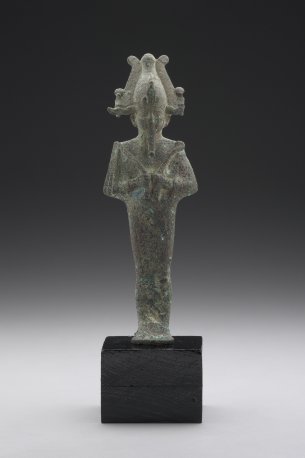Bronze Statue of Osiris
Overview
Bronze Statue of Osiris [ edit ]
This surprisingly heavy bronze statuette depicts the mummiform god Osiris wearing his standard attire, a close-fitting shroud. His wrists and hands poke out of vertical slits and meet in the center of his body, just below his chest. He grasps a flagellum in his right hand and a short-handled heka scepter (which could suggest a Theban provenance) in his left. Osiris wears the atef crown (consisting of the Upper Egyptian white crown flanked by two lateral plumes and a uraeus, whose body extends up the crown). A pair of twisted ram horns are horizontally placed at the base of the crown, above the god’s ears. Rising from the tips of the horns, flush against the plumes, are two small uraei with sun disks. In profile, one can see the lower bodies of uraei coiled behind the horns. The god has a small head with a round face, flush cheeks, thick lips, almond-shaped eyes, large ears, a long nose which flares out at the nostrils, a small chin, and a false beard. His expression is one of calm. He has a sturdy neck which rests upon a body that has little detail and is flat in profile. From the frontal view, only the calves and knees have been indicated. There is no writing on the piece, but incised decorative detail is clearly seen on the object. The lateral plumbs are decorated with incised diagonal striations. Decorative detail is also visible on the flagellum and scepter. Incised decoration denoting a broad collar can only be seen on the left side of the god’s neck. Delicate incisions were also used to indicate the braiding on the beard as well as the twisted nature of the crown horns. On the bottom of the statuette extends a 4 cm. vertical tang for the insertion into a separate base. Although the object is mostly green due to oxidation, it is in very good condition.
Period
760-330 B.C.
Dimensions
H. 21.5 cm
Museum
Yale Art Gallery
Accession Number
1956.33.80















